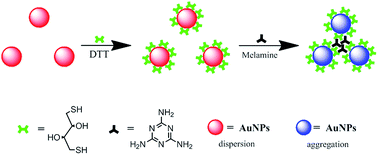Sensitive colorimetric detection of melamine with 1,4-dithiothreitol modified gold nanoparticles
Abstract
A colorimetric detection method for melamine based on 1,4-dithiothreitol (DTT) functionalized gold nanoparticles (DTT–AuNPs) is reported. Hydrogen-bonding interaction between DTT and melamine resulted in the aggregation of AuNPs, which consequently resulted in a color change of the AuNPs from wine red to blue and a red-shift of the surface plasmon resonance (SPR) peak of the DTT–AuNPs. The concentration of melamine could be determined by the naked eye or using a UV-vis spectrometer. FT-IR and TEM were used to investigate the modification of DTT–AuNPs. The results showed that the absorption ratio (A680/A520) was linear with the logarithm of melamine concentration in the range of 8.0 × 10−8 M to 6.0 × 10−7 M and 6.0 × 10−7 M to 1.5 × 10−6 M with linear coefficients of 0.993 and 0.999, respectively. The detection limit (S/N = 3) of the proposed method was 2.4 × 10−8 M, which is considerably lower than the safety limit. Coexisting substances did not affect the determination of melamine. Furthermore, the proposed method was applied for the detection of trace amounts of melamine in real milk samples with recoveries of 96–103%.


 Please wait while we load your content...
Please wait while we load your content...